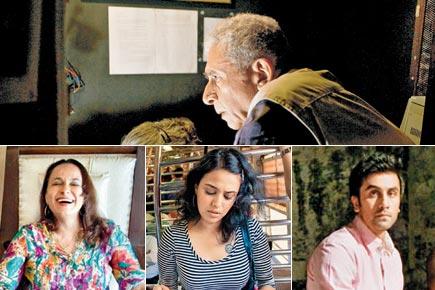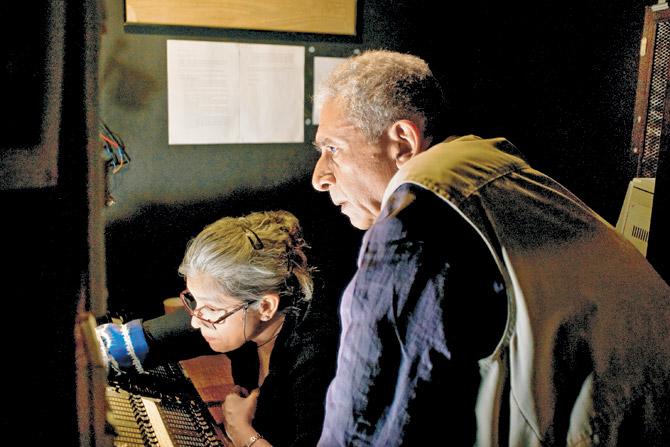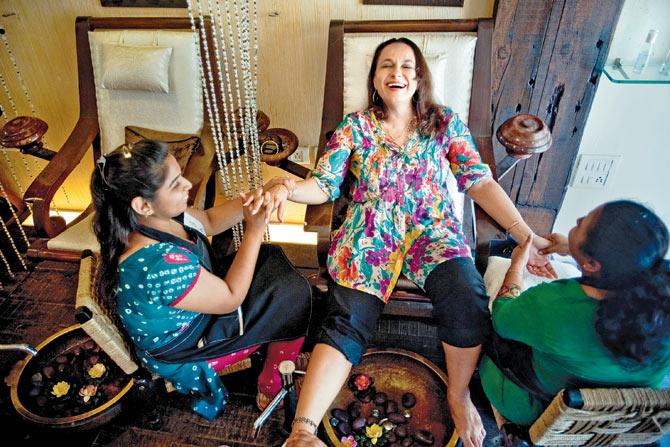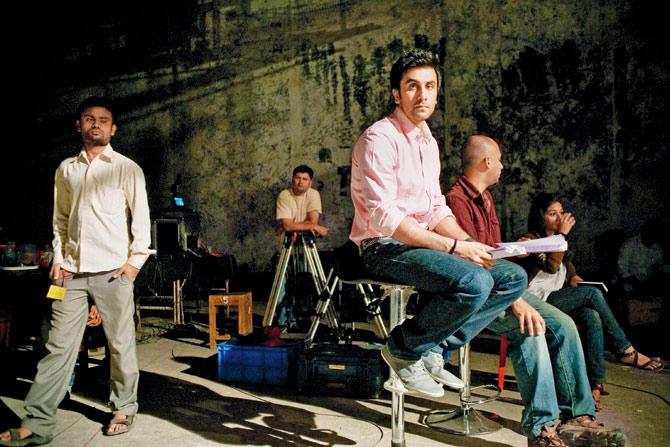New York photographer Mark Bennington on what it takes to bag an informal photo of a Bollywood star

Naseeruddin Shah, Ratna Pathak, Mark Bennington, Soni Razdan, Swara Bhaskar, Ranbir Kapoor

Naseeruddin Shah and Ratna Pathak Shah watch a rehearsal in progress from the lighting booth at Prithvi Theatre in Juhu. "If somebody told me I couldn't act any more, I'd put a gun to my head and blow my brains out! That’s what acting means to me," says Naseerudin. “Theatre is the space that I've grown up in and I guess it was a natural progression for me to start acting," says Ratna. PICS and text COURTESY/Mark Bennington, HARPERCOLLINS INDIA
ADVERTISEMENT
In January 2010, when New York-based photographer Mark Bennington was getting on to a flight to India, the plan, he recalls, was to spend two weeks in the city for a "simple comparing and contrasting photo essay about the acting communities of Los Angeles and Mumbai."
It's been seven years since that trip, and the change in plan finds proof in his just-launched coffee table book, Living the Dream (HarperCollins India), a compilation of 113 photo essays of actors from Mumbai's entertainment industry.

Mark Bennington started the Living The Dream project in early 2010. In the last six years, he shot over 126 actors, of which 113 were finally shortlisted for the book
With the aim of capturing a real glimpse of life behind the camera, he looks at a struggler's tenacity to hold on to a dream, the after-life of success, and a superstar's battle with unbridled fame. Bennington manoeuvres through various junctures in an actor's life in an attempt to humanise them. Edited excerpts from an interview:

Yesteryear actress Soni Razdan, also Alia Bhatt's mother, enjoys a pedicure at a salon in Lokhandwala
What about Bollywood had you realise it was an interesting industry to follow?
It happened by fluke. My mentor, David Alan Harvey, a photographer with National Geographic, and I were discussing book ideas and he told me I should do a book on actors in Los Angeles. It was around that time that I happened to visit India. It was a mid-life transition journey, where I was taking pictures of the country and the people, and then when I came to Mumbai, I thought why not meet up with the acting community here. I reached out to someone in LA to find me a contact, and the only thing they told me was, go to Bandra.
I was led by a layman's curiosity. Until then, I had never seen a Bollywood film and couldn't name a single star. Then, I met Guneet Monga [producer], now a dear friend, who put me through to Shanoo Sharma [casting director], and that's how the book took shape. The book couldn't have happened without Shanoo. I was getting a certain level of actors and beyond that, people would just not attend my calls. So, two to three months into my project, it all came to a standstill. And then, suddenly, I meet Shanoo, and she really took a keen interest in my work. She just picked up the phone, and called all the actors, whom she was in direct contact with. She changed the dynamics of this book.

Swara Bhaskar reviews a script on a local train from Andheri to Churchgate
What were you looking for back then?
I was looking for a connective tissue that bound all these stories. Theoretically, every person in the book is connected by a dream, and because dreams are not finite, they are all literally living the dream.
The other thing I was looking for, visually, was to humanise the acting industry. For example, the photograph of Naseerudin [Shah] and Ratna [Pathak Shah] shows how much they are driven by theatre and acting. It was taken in the lighting booth, and they were right in the middle of checking for their show. That to me, encapsulated what they are about, which is theatre. I had a really difficult time shooting Salman [Khan] because he is photographed so much, and every single frame looks like the other.
I had to spend two full days with him, before I managed to get him on the terrace of a building in Pune [where he was shooting] surrounded by onlookers and crazy fans. Not many people in the world have that command over people.

Ranbir Kapoor takes a moment between takes for a commercial ad shoot at Yash Raj Films studio in Andheri
In the book's prologue, Karan Johar writes about actors believing they are unattractive. They end up projecting vanity and this often becomes insanity. Did you catch a glimpse of this vanity?
Well, yes. Actors are vain, but people, in general are vain. That's why we have mirrors and that's why we take so many selfies. The acting community is more susceptible to it because what they are selling is their looks. But, gradually, the industry is turning reality-driven. There are people in the business who are not that concerned [about vanity].
The book has a mix of big names, theatre actors, TV stars and small-timers. Was it deliberate? Why did you choose these names?
I wanted to represent clusters of acting groups. Salman represents the Khans, Dharmendra and Hema [Malini] go back to the Sholay period and Alia [Bhatt] and Ranveer [Singh] are the new superstars. Somebody told me that I shouldn't put the stars and strugglers together. And I said, no, this project is not about hierarchy. That's one of the reasons why at least two people (I won't mention names), didn't want to be part of the book. They wanted to be in a book that had people of their stature, or not at all. And that's fine.
Which star did you want to include, but couldn't?
There are some obvious names missing from the book. But, like I said, I only wanted to include those who wished to be in the book and understood the idea behind the project. Of course, I was dying for Amitabh Bachchan to come on board. He politely declined. But, I have immense respect for him as an actor. Then, there was Shah Rukh Khan and Anil Kapoor, and both again said, no. But, I think I have captured the entire community. A few leaves may be missing here and there but, I think I have captured the tree.
 Subscribe today by clicking the link and stay updated with the latest news!" Click here!
Subscribe today by clicking the link and stay updated with the latest news!" Click here!






